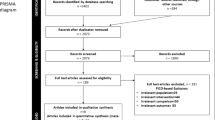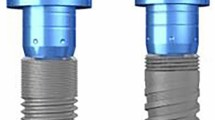Abstract
Design A randomised controlled trial study comparing patient-reported outcome measures (PROMs) and experiences (PREs) using conventional brain-guided (free-hand), dynamic computer-assisted implant surgery (dCAIS) and static computer-assisted implant surgery (sCAIS) for dental implant placement.
Case selection Ninety subjects who met the inclusion criteria (that is, at least 20 years of age interested in dental implant treatment) accepted to participate in the trial and were randomly allocated to three groups between August 2019 and October 2020, according to the dental implant placement protocol, by means of block randomisation. The included subjects were required to undertake several self-administered questionnaires concerning: 1) pre-operative expectations (that is, five items evaluating patients' perceptions using a 5-point Likert scale and six items about patients' expectations concerning the planned surgery); 2) post-operative healing complications or events during the immediate post-operative week (that is, pain intensity assessment on a continuous visual analogue scale [VAS] 0-10, oedema or swelling evaluation on four grades ranging from no oedema [Grade 1] to extraoral oedema reaching beyond the surgical zone [Grade 4] and analgesic drugs intake); and 3) post-operative PROMs at a two-week follow-up (six items evaluating the post-operative symptoms experience and eight items measuring overall patient satisfaction using a 5-point Likert scale).
Data analysis Kolmogorov-Smirnov test determined a non-normal distribution. Consequently, Wilcoxon signed-rank test assessed the intra-group differences and Kruskal-Wallis test was applied for inter-group comparison using the Statistical Package for the Social Sciences (IBM SPSS version 24; Chicago, IL). Spearman's correlation test evaluated the relation of patients' or implant procedures' characteristics with the maximum mean pain score, analgesic intake and oedema grade. The significance level alpha was set to 0.05. Lastly, Cronbach's alpha was used to evaluate the internal consistency for perceptions (0.53), expectations (0.76) and satisfaction (0.85).
Results Only two subjects were excluded for missing the two-week follow-up visit. Both subjects belonged to the dCAIS group. Hence, 88 participants (mean age = 57.7 years) corresponding to 179 implants placed were evaluated. Sex was the only subjects' characteristic with a significant difference as more women were included (60%; p = 0.020). Most of the subjects had one (38%) and two (45%) dental implants at anterior (11%) and posterior sites (80%) with full-thickness flap operation (95%) but without simultaneous guided bone regeneration (57%). In terms of the surgical duration, sCAIS took the longest (89.70 ± 45.75 min), followed by dCAIS (70.95 ± 42.48 min) and brain-guided protocol (70.30 ± 47.08 min). Nevertheless, there was no significant inter-group surgical time difference (p = 0.076). Concerning the pre-operative patients' perspectives on dental implant intervention, most participants believed that implants would permit chew (93%), sound (88%) and appearance (91%) to be as close as with natural dentition. Interestingly, 32% believed that osseointegrated implants require less maintenance than natural dentition and 73% stated that implants last a lifetime. There was a significant difference between the groups regarding the both the amount of time they expected to be in pain postoperatively (p=.035) and the amount of post operative swelling they expected (p=0.006)
There was no significant inter-group difference in magnitude of post-operative pain, oedema and analgesic intake. The dCAIS group expected longer to adapt to speaking (p = 0.030). The inter-group analysis of expected chewing difficulties evidenced significant differences (p = 0.040). Regarding the PREs, significant inter-group differences were displayed in duration of post-operative pain (p = 0.010), phonetic limitations (p = 0.038) and impact on routine activities (p = 0.046). After one week, the conventional and the sCAIS groups still had the highest (1.40 ± 2.43) and lowest (0.77 ± 1.85) pain scores. Concerning the self-reported post-operative oedema grading, it peaked on day two and most participants referred intraoral oedema (Grade 2) to extraoral oedema (Grade 3). Again, no significant inter-group difference was detected in the six measured time points regarding pain, oedema or analgesic intake. The highest post-operative oedema at day two was significantly correlated with flap operation (p = 0.030). During the first post-operative week, there was a low mean analgesic intake (5.13 ± 5.52). The first post-operative day had the highest consumption of analgesic drugs and the highest group consumption was by the conventional group. The post-operative healing experience and functional limitations were considered acceptable by most participants. Oedema had the lowest acceptable proportion (59%), followed by oral hygiene care difficulty (64%) and chewing (65%). The only intra-group difference in patients' acceptance was evidenced in the post-operative speaking difficulties of the sCAIS group (p = 0.015). Ninety-two percent of participants were satisfied with the clinical service (median = 5.0) and 89% were satisfied with the overall implant surgery (median = 4.0).
Conclusions Placing dental implants with conventional brain-guided, sCAIS or dCAIS protocols obtained a similar post-operative level of patient satisfaction, analgesic intake, oedema and pain. Patients reported the dental implant post-operative symptoms to be acceptable even though they expected a shorter inflammation duration. The highest level of pain and oedema were experienced six hours and two days post-operative, respectively, regardless of the surgical protocol.
This is a preview of subscription content, access via your institution
Access options
Subscribe to this journal
Receive 4 print issues and online access
$259.00 per year
only $64.75 per issue
Buy this article
- Purchase on Springer Link
- Instant access to full article PDF
Prices may be subject to local taxes which are calculated during checkout
Similar content being viewed by others
Change history
25 March 2022
A Correction to this paper has been published: https://doi.org/10.1038/s41432-022-0234-2
References
Yao C J, Cao C, Bornstein M M, Mattheos N. Patient-reported outcome measures of edentulous patients restored with implant-supported removable and fixed prostheses: A systematic review. Clin Oral Implants Res 2018; 29 Suppl 16: S241-S254.
Bryant S R, Walton J N, MacEntee M I. A 5-year randomized trial to compare 1 or 2 implants for implant overdentures. J Dent Res 2015; 94: 36-43.
Afrashtehfar K I, Igarashi K, Bryant S R. Canadian dental patients with a single-unit implant-supported restoration in the aesthetic region of the mouth: qualitative and quantitative patient-reported outcome measures (PROMs). Data 2021; 6: 90.
Eitner S, Wichmann M, Schlegel K A et al. Oral health-related quality of life and implant therapy: an evaluation of preoperative, intermediate, and post-treatment assessments of patients and physicians. J Craniomaxillofac Surg 2012; 40: 20-23.
di Torresanto V M, Milinkovic I, Torsello F, Cordaro L. Computer-assisted flapless implant surgery in edentulous elderly patients: a 2-year follow up. Quintessence Int 2014; 45: 419-429.
Dong H, Zhou N, Liu H et al. Satisfaction analysis of patients with single implant treatments based on a questionnaire survey. Patient Prefer Adherence 2019; 13: 695-704.
Engkawong S, Mattheos N, Pisarnturakit P P et al. Comparing patient-reported outcomes and experiences among static, dynamic computer-aided, and conventional freehand dental implant placement: A randomized clinical trial. Clin Implant Dent Relat Res 2021; 23: 660-670.
Popescu A, LeResche L, Truelove E L, Drangsholt M T. Gender differences in pain modulation by diffuse noxious inhibitory controls: a systematic review. Pain 2010; 150: 309-318.
Pozzi A, Tallarico M, Marchetti M et al. Computer guided versus free-hand placement of immediately loaded dental implants: 1-year post-loading results of a multicentre randomised controlled trial. Eur J Oral Implantol 2014; 7: 229-242.
Kunzendorf B, Naujokat H, Wiltfang J. Indications for 3-D diagnostics and navigation in dental implantology with the focus on radiation exposure: a systematic review. Int J Implant Dent 2021; 7: 52.
Ravidà A, Barootchi S, Tattan M et al. Clinical outcomes and cost effectiveness of computer-guided versus conventional implant-retained hybrid prostheses: A long-term retrospective analysis of treatment protocols. J Periodontol 2018; 89: 1015-1024.
Lang N P, Zitzmann N U, Working Group 3 of the VIII European Workshop on Periodontology. Clinical research in implant dentistry: evaluation of implant-supported restorations, aesthetic and patient-reported outcomes. J Clin Periodontol 2012; 39 Suppl 12: S133-S138.
Afrashtehfar K I, Assery M K A, Bryant S R. Patient satisfaction in medicine and dentistry. Int J Dent 2020; DOI: 10.1155/2020/6621848.
McGrath C, Lam O, Lang N. An evidence-based review of patient-reported outcome measures in dental implant research among dentate subjects. J Clin Periodontol 2012; 39 Suppl 12: S193-S201.
Afrashtehfar K I, Assery M K A, Bryant S R. Aesthetic parameters and patient-perspective assessment tools for maxillary anterior single implants. Int J Dent 2021; DOI: 10.1155/2021/6684028.
Ali K, Kay E J. Which type of soft tissue augmentation at dental implant sites is best supported by evidence? Evid Based Dent 2020; 21: 140-141.
Author information
Authors and Affiliations
Corresponding author
Rights and permissions
About this article
Cite this article
Afrashtehfar, K. Conventional free-hand, dynamic navigation and static guided implant surgery produce similar short-term patient-reported outcome measures and experiences. Evid Based Dent 22, 143–145 (2021). https://doi.org/10.1038/s41432-021-0216-9
Received:
Accepted:
Published:
Issue Date:
DOI: https://doi.org/10.1038/s41432-021-0216-9
This article is cited by
-
Short-term data suggests cognitive benefits in the elderly with single-implant overdentures
Evidence-Based Dentistry (2024)
-
Investigation on the application of digital guide templates guided dental implantation in China
BMC Oral Health (2023)
-
Lack of keratinized mucosa increases peri-implantitis risk
Evidence-Based Dentistry (2023)
-
Lack of association between dental implants and oral squamous cell carcinoma
Evidence-Based Dentistry (2022)
-
Preoperative administration of amoxicillin is not recommended in healthy patients undergoing implant surgery
Evidence-Based Dentistry (2022)



